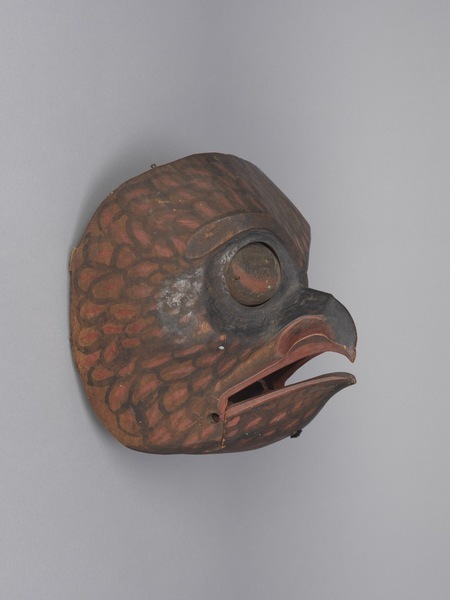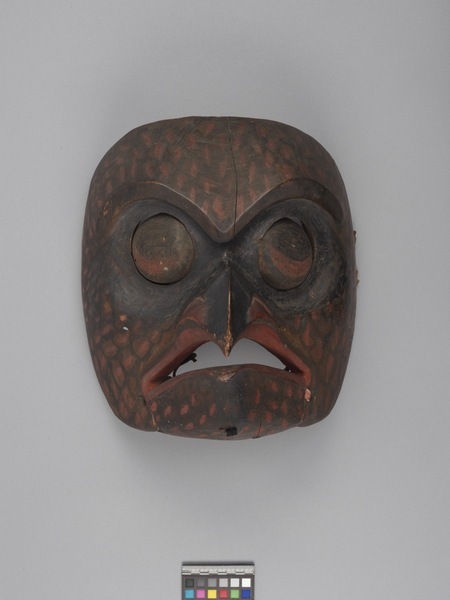Mask Item Number: 3260/113 from the MOA: University of British Columbia



Description
Large owl mask with moveable jaw and eyes. Eye holes are carved out, sides of nose have semi-circular red shapes, and the mouth is painted red. Black design on mask depicts feathers with red details. On reverse are cotton and cedar(?) bark ties controlling the movements of the jaw. A hide tongue is tied to hide strips through the eyes. Three hide strips are nailed to the sides; two other nails protrude at top edge. (Metal wire for hanging on back.)
History Of Use
With its articulated eyes and moveable jaw, boldly painted feathers, and combination of reflective black graphite and red vermilion pigment, this owl mask was made to achieve its full dramatic effect while in motion, worn by a skilled dancer in ceremony. As is true of many masks that were made for use and eventually circulated through the art market, now missing are the cloth head-covering and other rigging that allowed the mask to be worn and the moving parts to be manipulated with strings [Karen Duffek, 2019]. Masks used in storytelling and masks sold in the art market serve two very different purposes for two different audiences. Masks sold in the market are put up on display in homes, whereas masks that were used culturally would have been taken out only during certain times [Nakkita Trimble – Nisga’a, 2019].
Narrative
No record has been found of who originally owned this mask or the circumstances of its leaving. Eventually, however, it was acquired by the Brazilian sculptor Maria Martins (1893--1973); in the mid 1940s, she joined the surrealists exiled in New York, some of whom collected and sought inspiration in Northwest Coast art. The mask later circulated through other private collections and was purchased by Elspeth McConnell in 2015.
Item History
- Made in British Columbia, Canada during 1850
- Owned by Elspeth McConnell before August 12, 2017
- Received from Elspeth McConnell (Donor) on August 12, 2017
What
- Name
- Mask
- Identification Number
- 3260/113
- Type of Item
- mask
- Material
- metal, plant fibre, alder wood, paint, cotton fibre and rawhide skin
- Overall
- height 32.0 cm, width 31.0 cm, depth 24.0 cm
Who
- Culture
- Tsimshian ? or Nisga'a ?
- Previous Owner
- Elspeth McConnell
- Received from
- Elspeth McConnell (Donor)
Where
- Holding Institution
- MOA: University of British Columbia
- Made in
- British Columbia, Canada
When
- Creation Date
- during 1850
- Ownership Date
- before August 12, 2017
- Acquisition Date
- on August 12, 2017
Other
- Condition
- fair
- Accession Number
- 3260/0113